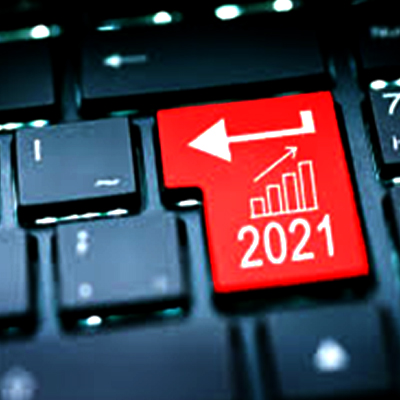Key HR Trends in 2021 | Aparna Sharma | Consulting Editor | The People Management
 Hardly anyone could have predicted the disruption that the COVID pandemic would have caused in our lives & work, and now its influence is set to continue well into 2021 & beyond. The 2021 HR trends are all linked to the pandemic and how it is re-shaping the new working world.
Hardly anyone could have predicted the disruption that the COVID pandemic would have caused in our lives & work, and now its influence is set to continue well into 2021 & beyond. The 2021 HR trends are all linked to the pandemic and how it is re-shaping the new working world.
1. Remote Working and Learning
It only takes a couple of statistics to start realising how much of a head-scratcher the remote working and returning to offices issue might be in the long term. 82% of remote managers are concerned about employee focus and productivity, but 98% of employees want the option to work from home for at least some of the week across the rest of their careers.
2021 is probably going to be about finding the middle ground and a remote approach that works for everyone. For that to happen, there’s a few creases to iron out.
There are plenty of employee perks to remote working – flexible schedules, no commuting and more free time to spend with loved ones. So, in theory, if the working-from-home advocates can convince on the productivity and focus issue, everyone will be happy, right? Not quite. Not all that extra time has been invested in a better work-life balance, you see.
Four in five HR managers believe the move to working remotely has caused ‘EPresenteeism’, with employees feeling the need to be online and available as much as they can. And, on an average, people at home were spending an extra 28 hours working each month from lockdown-onwards. Microsoft teams data that shows more people communicating with colleagues on weekends and you realise just how much of a challenge leaders and employees have in establishing remote boundaries between work and life.
Those that opt for an entirely remote approach will have to consider technology and equipment needs for employees as they shape their more permanent home setups. Those dining tables have manned the fort admirably, but proper desks and chairs are the long-term solutions. And if the week’s going to be split between home and the office, there’s the logistical decision around having a fixed office or going for something more flexible.
One constant will be how to communicate, collaborate and learn in a remote working world. Reduced team cohesiveness was another top concern for remote managers (72%) and communication &/ collaboration was in the top 3 struggles for remote employees. The big question for 2021 should probably be: if we can’t get together in person, what’s the next best thing?
The answer is finding a platform that acts as a knowledge base for your resources , however let people add their own insights and share them with all their colleagues. That creates a situation where, even when people are fragmented, the knowledge they need isn’t! If you can’t tap on a colleague’s shoulder, you should be able to tap your question into a search bar and still get the answers.
2. Diversity, Equity and Inclusion
It’s probably been on the trends list for the past few years, but with 2020 shining a spotlight on a raft of issues around diversity, it’s likely that 2021 could be the biggest year for diversity, equity and inclusion (DE&I).
It’s an issue that often throws up more hot potatoes than the office canteen, so maybe it’s best to cool those down by looking at some statistics. According to the World Bank, gender equality in workplaces could aid the global economy to the tune of £120 trillion, while McKinsey revealed that more gender and ethnic diversity in teams can drive profitability by 21% and 33%, respectively.
These are often the issues that spring to mind when someone mentions DE&I, but with the remote revolution of workplaces in mind, there will be further concerns for leaders and HR teams in 2021. Most obvious is the challenge of maintaining and establishing company cultures when people are working disparately. How do they make sure people feel included and connected when they’re apart?
A changing workplace will lead companies to look at diversity in many senses of the word, like diversity of thought, working experiences, personalities and education. And it’s likely to start with analysis: what does that data say about the current workforce? What’s lacking? And how to address that in 2021?
3. Employee Wellbeing and Mental Health
You’d have to be pretty heartless not to put some energy into employee wellbeing in 2021, after the challenges and disappointments of 2020 – it could be hugely beneficial to your entire business. The main reason is that employee wellbeing is intrinsically linked to productivity.
Presenteeism (13.4%) and absenteeism (1.1%) accounted for 14.5% of lost working hours in 2019, according to a Vitality study. That equated to a loss of 38 productive days per employee per year, rising from 23 days in 2014. So, it’s likely that the 2020 increase could be eye-watering. Given that only 51% of employees feel comfortable talking about mental health at work and that’s a pre-COVID number, working remotely and doubting job security could make it much worse.
The solution? Expect an increase in the use of employee wellbeing apps in 2021.These apps allow people to monitor patterns in their moods, sleep and general health, while offering content to coach and guide them through these issues.
Another is to focus on their development. Managers are concerned about employee career implications when working remotely and more than a third of employees believe their managers not seeing in-person contributions would damage their progression. The best way to ease these fears is to put someone on a path to development and learning new skills, showing them that they’re valued and there’s a vision for their future in the company.
Leaders need to think outside the box too, to get creative and make sure employees are having fun, connecting with their peers and generally enjoying work. Lockdown has showed us that necessity is the mother of social invention, from companies creating walking/running challenges and leaderboards to cocktail and doughnut decorating classes. The same kind of energy is needed in 2021.
4. Learning in the flow of work
Before you scroll down, how long do you think people spend searching for information each day? You might be surprised…
In 2012, McKinsey stated that employees spent 1.8 hours searching for information each day, by 2015 it had risen to 2.5 hours. That’s almost a third of the working day! And then the research trail tails off a little, but there was one article on a 2019 survey that puts the number at 25% of their day.
Once you factor in time spent on checking emails and getting snacks or a coffee, when are people meant to do their jobs and how are they going to do it productively? The answer is gaining back all that wasted time by allowing people to learn as they work, to give them the tools to find whatever information they need when they need it.
5. Data-Driven strategies
Another one that’s been tipped for years but will probably take off in 2021, HR teams are more likely to lean on data as they make their decisions. Why? For a lot of the reasons stated earlier ; more employees will work remotely, and that means HR teams will face the challenges of instilling the company culture, recruiting the right people and giving them the tools to be productive and happy.
Budgets are changing, workforces are changing and that means decision makers might need more convincing to buy into products, platforms and strategies. And it’s as simple as the idea that you can’t argue with the facts. If you’re presenting a compelling case for why a learning platform might help a smaller team cover lost skills or why a particular app will drive productivity, retention or engagement, you’ll certainly help your cause by including some data.
By the same token, HR teams will tap into the existing data to learn more about the habits of their workforce, which tools they’re actually benefiting from and, well, anything else that the data throws up. What we’re saying in a long-winded way is that, with the 2020 everyone’s just gone through, the pressure’s really on to get it right in 2021. Don’t act off instinct, not until you’ve understood the data.


